How to Get Rid OfSquirrels
37 min read Updated for March, 2019
It seems like everywhere you look you see a squirrel—in the park, the backyard, a restaurant parking lot. They can often seem like friendly, non-aggressive creatures—but don’t be fooled. It’s best to leave squirrels alone. Sometimes, the problem is they won’t leave you alone. Squirrels can create all kinds of property damage. They can tear up trees, wiring, insulation, wood parts of your home, vegetable gardens—you name it—squirrels might be able to gnaw on it and through it.
37 min read Updated for March, 2019
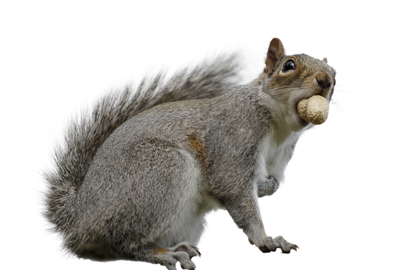
Squirrel Sounds
Squirrels are VERY vocal in communicating with one another, from chattering and chirping, to grunts and squeaks, to foot stomping and shrieking. Of course, non-verbal sounds—especially if they are in your attic and walls—include scratching, scraping, gnawing, and scurrying.
Squirrel Tracks
As a rodent, squirrels have five toes on both their front and hind paws with smaller front paws than hind. Their front paws are roughly half-inch by half-inch, the hind are longer—about an inch long and half-inch wide. In addition to the five clawed toes, they have several pads so some tracks may look like several little spots in addition to the toes. Tracks in mud or snow though, look more like handprints. Squirrels are also ‘bounders’ in their gait so tracks are often a foot or two apart.
Squirrel Poop
Squirrel droppings are usually small brown pellets about a half inch in length, with rounded ends, a little larger than rat droppings. Depending on species, they’ll be close in size to a jellybean, raisin, or pill. You’ll also find their poop in close proximity to the entrance they use to get into your home.
Identify
Common Species
Squirrels live on every continent except Australia and Antarctica. There are more than 200 species of the animal around the world, but the ones living in the United States fall into five different categories.
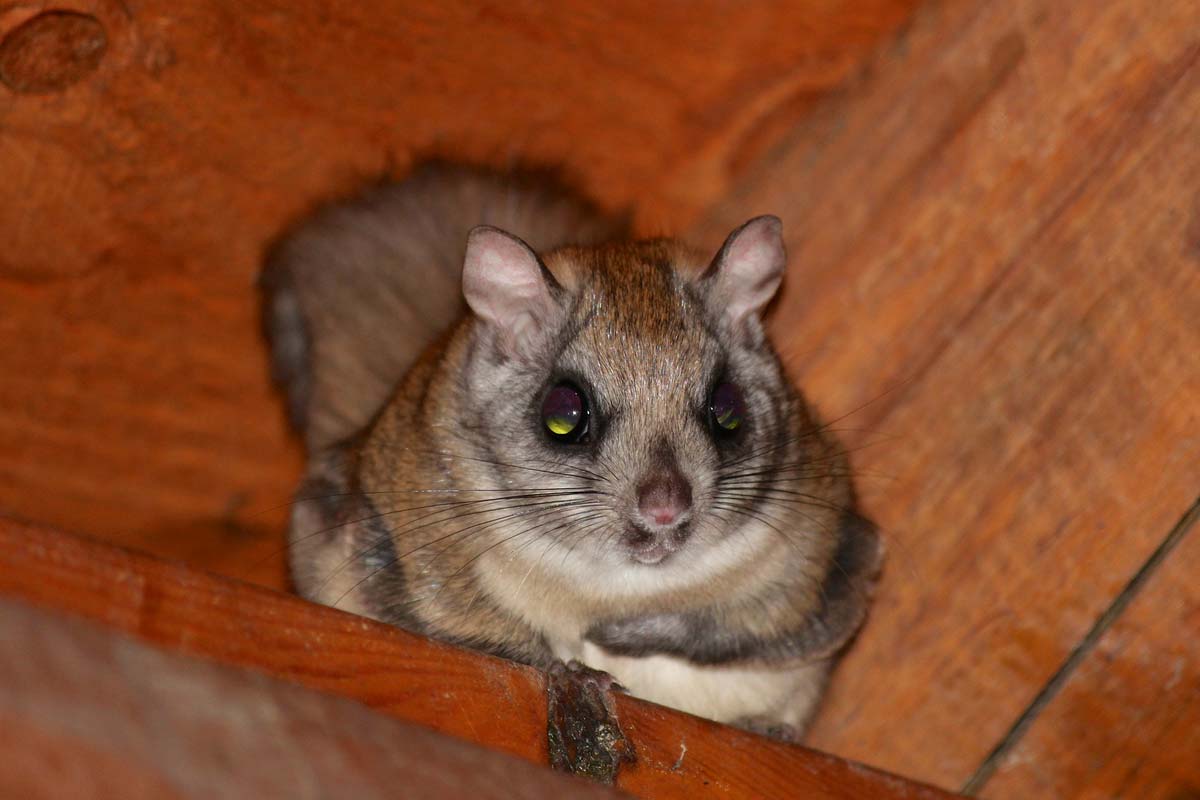
Flying Squirrel
Appearance
- Grayish-brown, gray belly, large black eyes, long flat tail
- Ten to 12 inches long, weighs less than five ounces
- Use furred ‘wing’ membranes attached to fore and hind legs to glide between trees
Behavior
- Found primarily in the Northeast, along West Coast, Idaho, Montana
- Nocturnal animals, lives in the forest, woodlands
- Eat mushrooms, nuts, acorn, lichen
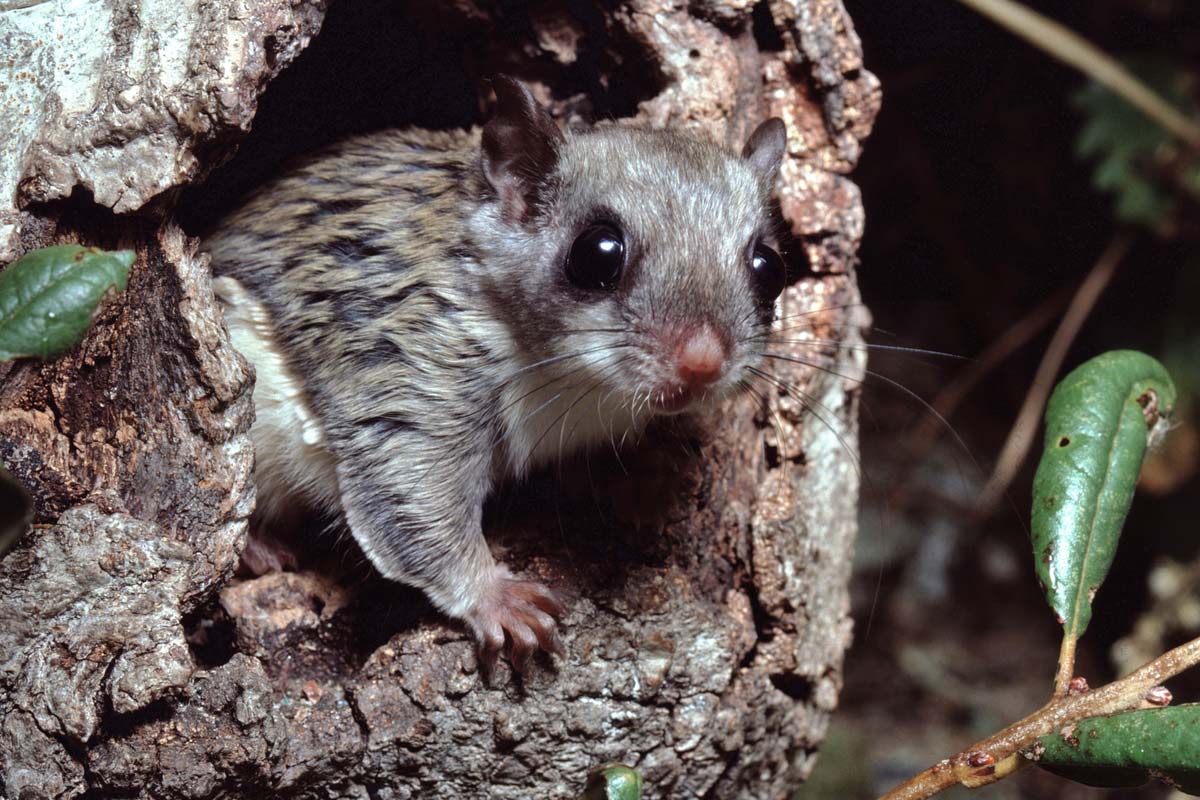
Flying Squirrel
Appearance
- Grayish-brown, white belly, large black eyes, long flat tail
- Eight to 10 inches long, weighs less than three ounces
- Use furred ‘wing’ membranes attached to fore and hind legs to glide between trees
Behavior
- Found in the eastern half of United States, from Maine to Florida, Minnesota to Texas
- Nocturnal animals, lives in the forest, woodlands
- Eats berries, seeds, fruits nuts, lichen
Squirrel Problem?
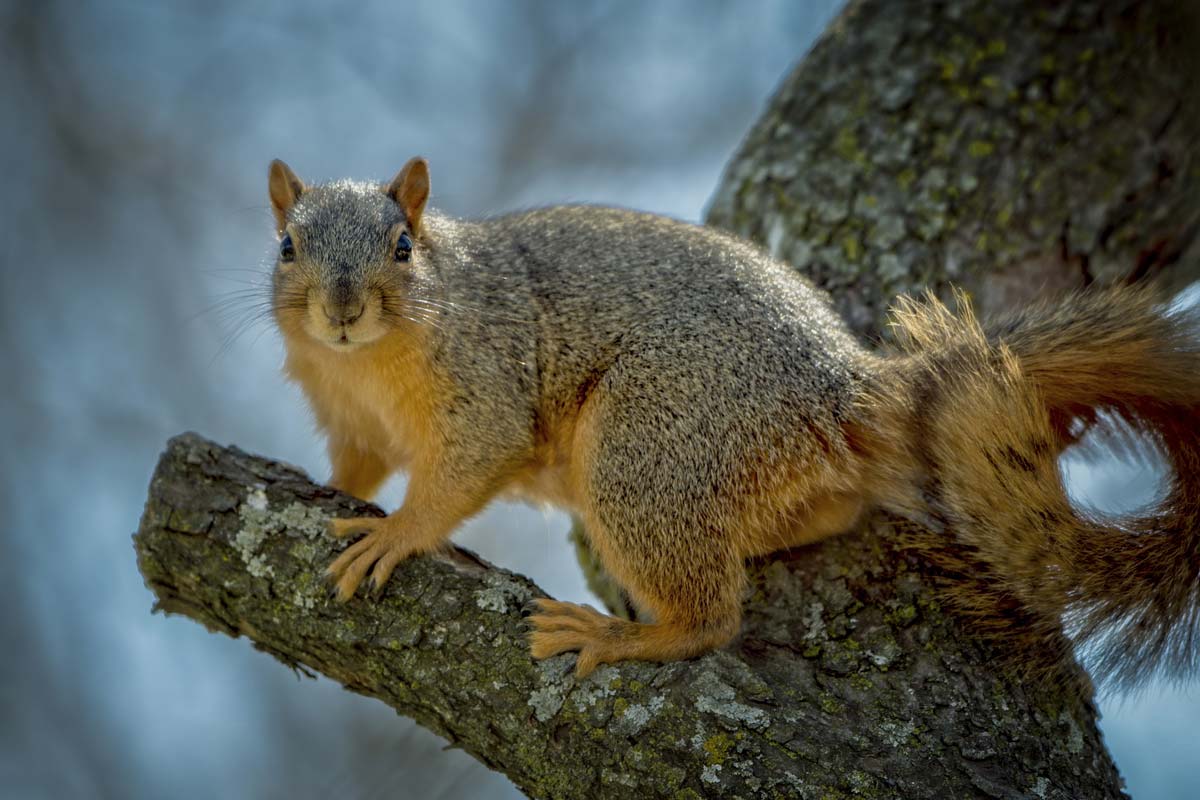
Fox Squirrel
Appearance
- Largest tree squirrel, 15 to 25 inches long, weighs less than three pounds
- Color varies based on location but mostly black, gray, reddish-brown bodies, brown or black bellies
- Sharp claws, bushy tail
Behavior
- Found in the eastern half of United States, but not in New England
- Lives in forests, but also found in cypress and mangrove swamps
- Eats acorns, hickory nuts, walnuts, seeds
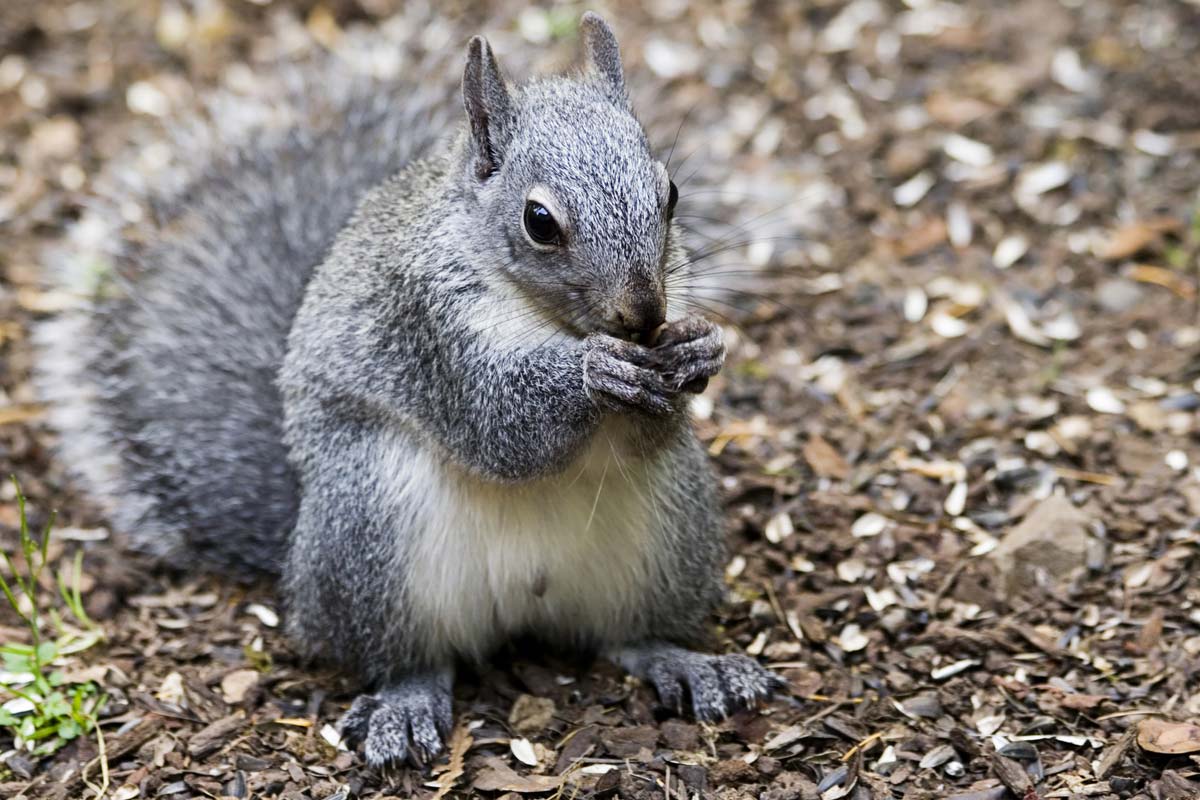
Gray Squirrel
Appearance
- Medium size, dark to pale gray bodies with a red tint, creamy white bellies
- White to gray narrow tail and short ears
- 18 to 20 inches long, weighs less than two pounds
Behavior
- Found in the eastern part of United States, California, Oregon, Washington
- Lives in trees, common in cities and developed areas
- Eats nuts, seeds, buds
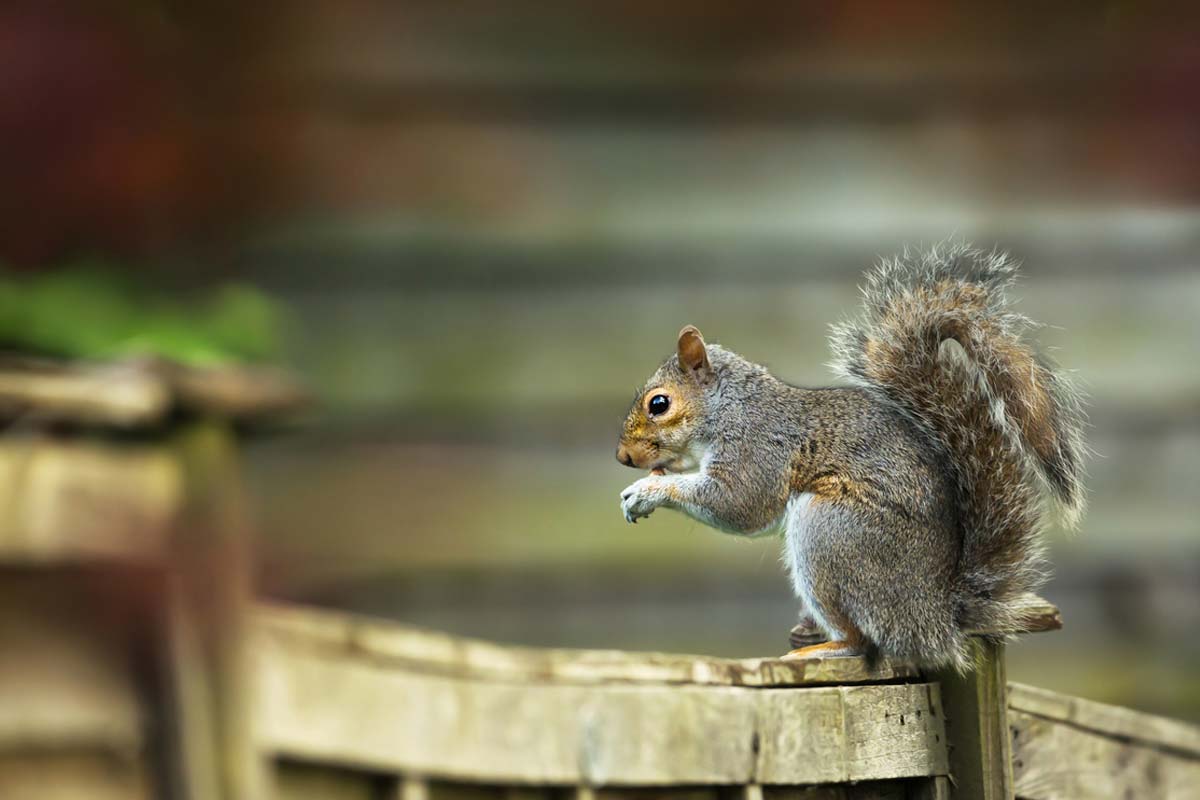
Gray Squirrel
Appearance
- Steel gray bodies, white bellies, long bushy, white-edged tails
- Large feet, back of ears turn reddish-brown in winter
- Nearly two feet long, weighs between one and two pounds
Behavior
- Found in Washington, Oregon, California, a small area of Nevada
- Eats acorns, seeds, mushrooms
- Lives in oak woods, forests, on the list of threatened animals in Washington
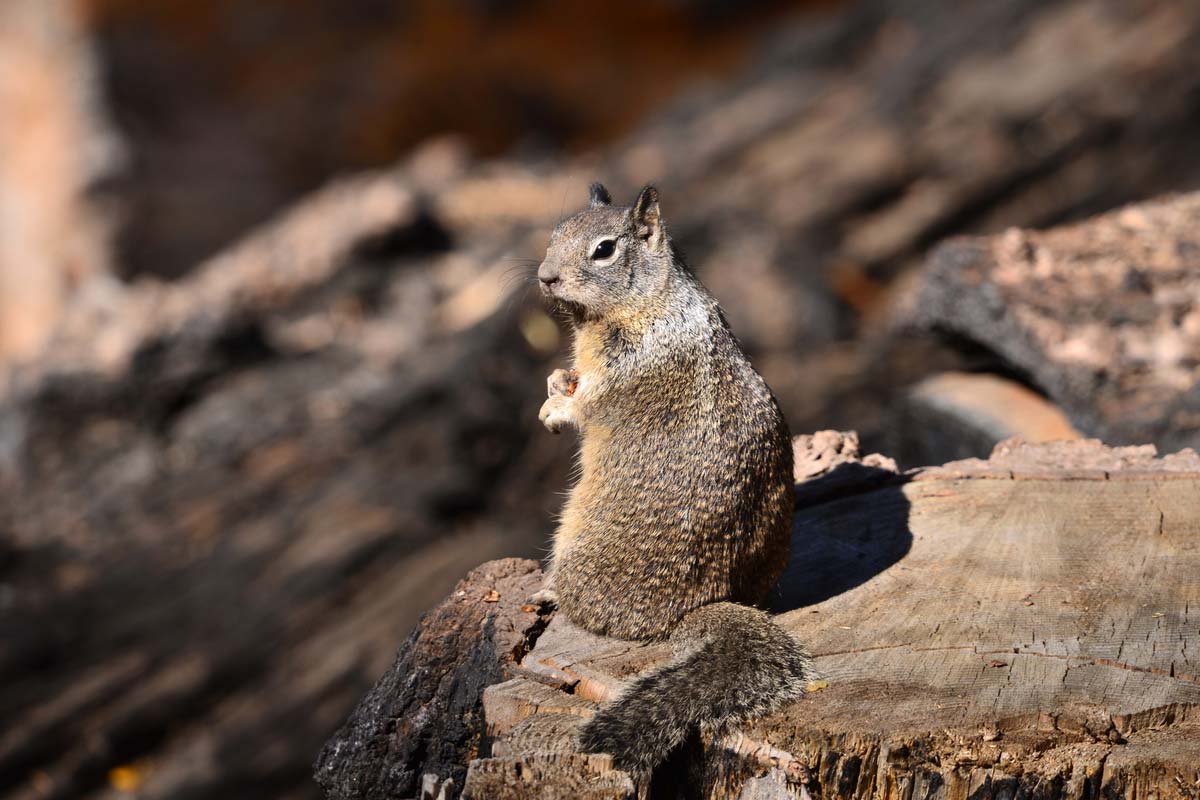
Ground Squirrel
Appearance
- Black, brown, reddish-brown bodies depending on the region of the country
- Soft puffy fur, white or gray bellies
- Eight to 12 inches long, weighs less than 10 ounces
Behavior
- Commonly found across the United States
- Can stand on hind legs, make a squeaking noise
- Lives in burrows, tunnels underground
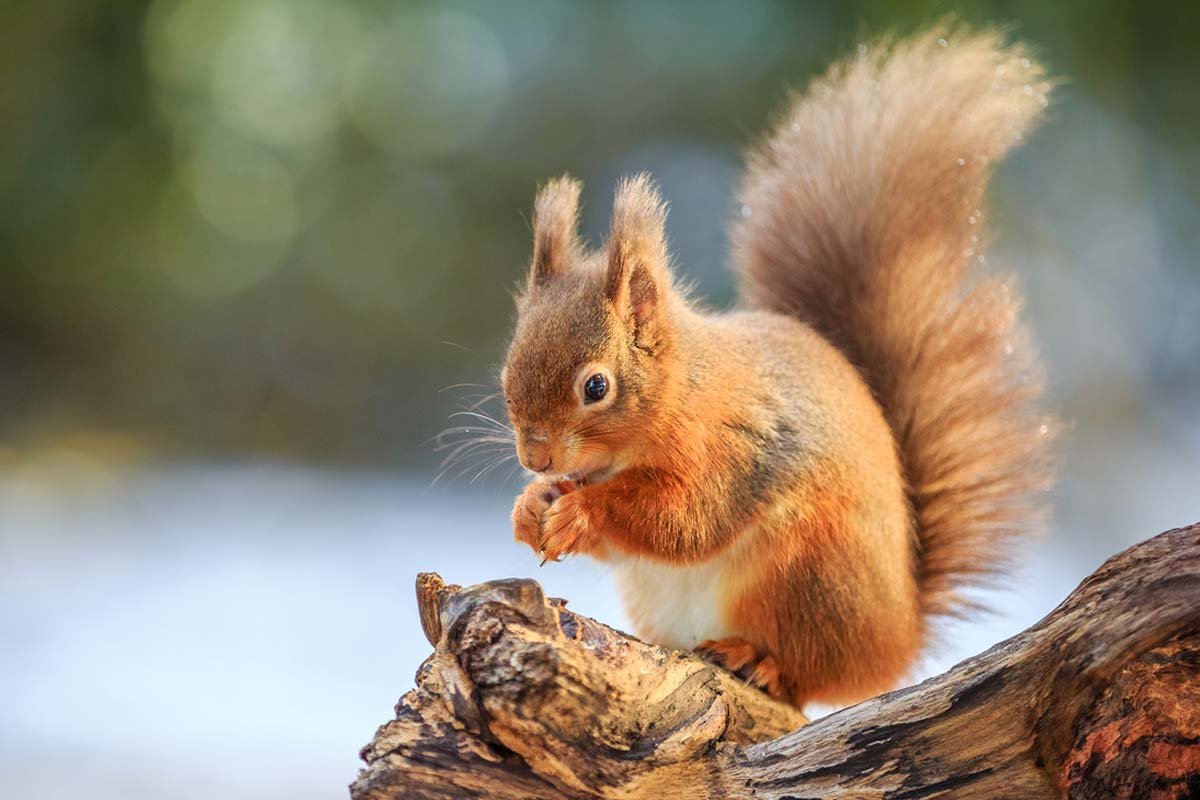
Red Squirrel
Appearance
- Small reddish to reddish-gray body, white or cream belly, prominent white ring around eyes
- Eight to nine inches long, weighs 12 ounces or less, may have a black stripe on sides during summer
- Curved front claws, shorter, less bushy tail than other squirrels
Behavior
- Found in Alaska, Rocky Mountain states, eastern United States
- Solitary, lives in forests, active in early morning, late afternoon
- Eats pine seeds, insects, bark, nuts, fruits, mushrooms
One interesting note about squirrels is their teeth never stop growing. Their front four teeth grow up to six inches a year, but stay short because they are constantly being used to gnaw.
Ground squirrels can climb but make their homes in the burrows and underground tunnels they dig.
Common Locations
The eastern and central part of the United States is where fox squirrels call home. You can find them as far west as Colorado, North Dakota, South Dakota, and Texas, but you won’t see them in New England, New Jersey or parts of New York and Pennsylvania.
A mostly solitary animal, they like to nest in tree hollows in mixed forests. But in the southern part of its range, you can find fox squirrels in cypress and mangrove swamps.
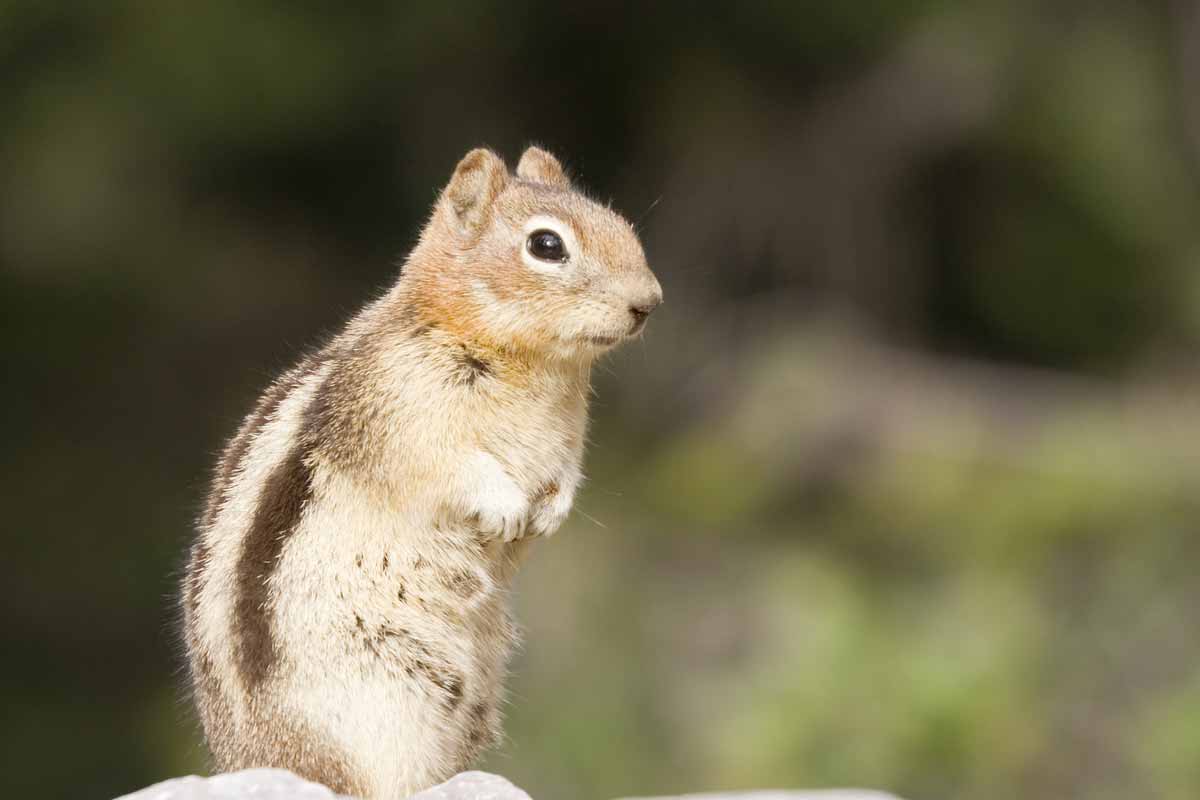
Ground squirrels live all across the United States, but unlike their other squirrel cousins, prefer to stay on the ground instead of in the trees. For this reason, they are more susceptible to predators and will sometimes use a whistling call to warn each other of danger.
Ground squirrels can climb but make their homes in the burrows and underground tunnels they dig. They stay away from thick, dense woods and wet areas and find wide open spaces or ditch banks, fence rows, near buildings or crops to burrow in.
Northern flying squirrels are found in Alaska, California, Idaho, Michigan, Minnesota, Montana, North Dakota, Oregon, South Dakota, Utah, Washington, Wisconsin, and Wyoming. You can also find them in the Appalachian Mountains from New England to North Carolina.
The nocturnal animal lives in dense mixed forests and is considered very social because it shares a nest and will live with up to eight other squirrels.
You can find the Southern flying squirrel in most of the eastern part of the United States all the way to Kansas, Minnesota, and Texas. It’s nocturnal so that you won’t catch many glimpses of the small animal. It prefers to live in mixed forests with lots of old trees.
Southern flying squirrels nest in tree cavities or abandoned woodpecker holes. Sometimes, it will make its own nest with leaves, bark, and twigs in the bend of a tree and will huddle with other squirrels to stay warm during winter.
The Northern and Southern flying squirrels don’t technically fly as their name implies. They have a loose fold of skin that stretches from their front to rear feet. When they spread out their legs, the skin forms a type of natural parachute that allows them to glide from branch to branch. The animal uses its tail as a rudder so that it can change direction.
As the name suggests, Eastern gray squirrels can be found in abundance in the eastern half of the United States as far west as the Mississippi River. They are also an introduced species in California, Oregon, and Washington. Eastern gray squirrels prefer to live in large, mature forests full of all kinds of trees, but you can find them in ample supplies in city parks and suburbs.
Eastern gray squirrels have two types of homes: a den, which is usually a hole in a healthy tree, often created by a woodpecker or a nest. Dens are typically used during the winter months and will house several squirrels at once. Eastern gray squirrels will also pack a lot of sticks and leaves together to make their nests high in forked branches of big trees. They prefer a continuous forest canopy, so they can forage, travel from branch to branch and protect themselves from predators by staying above ground.
Western gray squirrels reside in California, Oregon and Washington and a small area in Nevada. They are considered a threatened animal in Washington and they make their homes in wooded areas full of oaks and coniferous forests. They live in hollow trees or nests in branches made of twigs and lined with grass or moss. When they are afraid or feel threatened, they will make a loud barking sound, flick their tail and stomp their feet.
The Red squirrel can be found in the eastern part of the United States—as far south as northern Virginia and as far west as Illinois, Indiana, and Ohio. You can also find this type of squirrel in the Rocky Mountain states and Alaska.
This primarily solitary animal is most active early in the morning and late in the afternoon. It likes to live in forests with all different types of trees and makes its nest in tree hollows and logs. It may live alone, but the red squirrel isn’t a quiet animal. It chatters, growls and screeches.
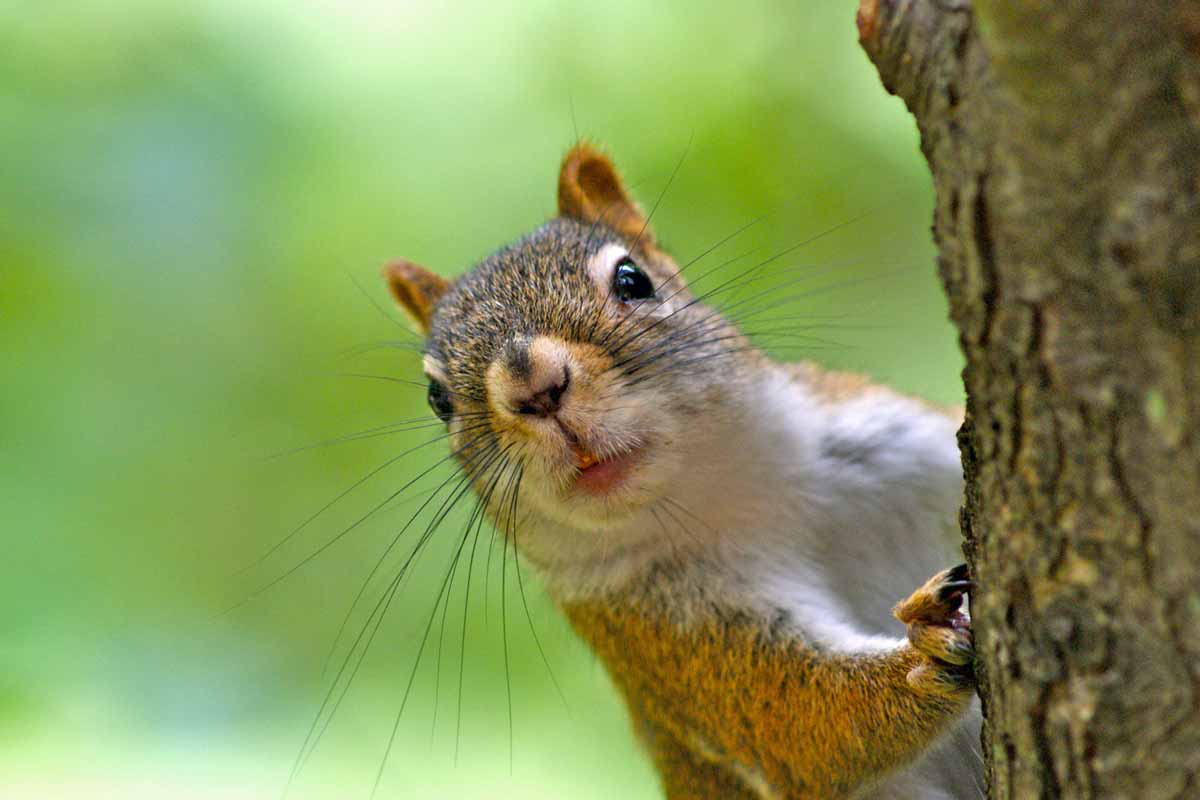
Squirrels eat about one pound of food a week, and they bury food to save for winter because the supply can be scarce in the coldest months of the year.
Why They’re Here
If you encounter a squirrel, the reason is simple—they are looking for food, burying and storing food, or looking for a place to nest. Sometimes, they may be doing all three things in the same place.
Squirrels eat about one pound of food a week, and they bury food to save for winter because the supply can be scarce in the coldest months of the year. It’s a practice called scatter-hoarding. Squirrels use their avid sense of smell to find the food later. They store more food than they need and the seeds and nuts they plant help replenish forests.
Fox squirrels eat acorns, hickory, walnut, beech, mulberry and hawthorn seeds. They will also eat fruits, berries, corn, insects, moths, and beetles. There isn’t a particular breeding season for fox squirrels because they can mate any time during the year. Mating typically reaches its peak in December and June, and the female will give birth to a litter of two to four babies about 45 days after becoming pregnant. Fox squirrels are born naked and blind, and their eyes won’t open until they are about five weeks old. They wean off three weeks later.
Northern flying squirrels feast on nuts, acorns, fungi, and lichens. They will also eat fruit, buds, sap, bird eggs and insects. They breed from March to May and females give birth anywhere from two to five babies about 40 days after becoming pregnant. Northern flying squirrel females only have one litter a year. They will use abandoned tree nests or woodpecker holes to wean the babies, which usually happens around two months of age.
You’ll find Southern flying squirrels where seed-bearing hardwood trees are plentiful. Hickory, maple, beech, and poplar are their favorites. They will also eat berries, seeds, fruits, lichen, tree bark, nuts, insects, eggs and dead animals. Mating happens in early spring and then again in late summer. Female Southern flying squirrels give birth to between two and seven babies about 40 days after becoming pregnant. The babies become independent at four months of age.

Eastern gray squirrels like oaks, walnuts and pine trees because they produce foods that last through the winter. These animals are very common in many cities and thrive in developed areas. They will take up residence wherever there is an abundance of tree nuts. They will also feed on seeds, fruits, mushrooms, tree buds, and blooms. They are very vocal little creatures. They squall, bark, mew, purr, and chatter their teeth to communicate with other squirrels.
Mating happens from late December to February and then again in May through July and usually produces two litters per female. One to eight babies are born per litter. The gestation period is usually around 45 days for the females.
Western gray squirrels eat berries, fungi, green vegetation, and insects, but they primarily eat pine nuts and acorns. Chances are you won’t see many of them since they are considered threatened in Washington and of concern in Oregon and California.
Mating season occurs from December to June. Females will have between one and five babies after about a 45-day gestation period. Western gray squirrels are around six months old when they leave the nest, which is longer than most other squirrels. Western gray squirrels make a hoarse “chuff-chuff-chuff” barking sound.
Of all the types of squirrels in the United States, ground squirrels are probably considered the biggest pest. Mostly because of their digging habit. Their diet changes with the season. Ground squirrels will eat grass, plants, seeds, grains, and nuts.
You can find them across the country and mating time depends on the area of the U.S. they live in, but they typically only breed once a year and females have between seven and eight babies per litter. The young grow quickly and usually wean around the time they are six weeks old.
Red squirrels mostly feed on pine seeds, but they will also eat insects, bark, sap, nuts, fruits, and mushrooms. In the fall, the animal will cut green pine cones from trees and store them in the ground. They also use logs or the base of trees to hide nuts and seeds for the winter months.
Red squirrels mate in late winter. Females will have between three and seven babies about a month after becoming pregnant. They will look for warm, safe places to raise the baby squirrels until it is time to wean them off of the mother, which is usually around eight weeks.
As more land gets developed, or forests are cleared out for timber, squirrels are forced out of their natural habitats and sent looking for new places to live. That can sometimes mean they end up calling your house home.
Squirrel Sounds
Squirrels are VERY vocal in communicating with one another, from chattering and chirping, to grunts and squeaks, to foot stomping and shrieking. Of course, non-verbal sounds—especially if they are in your attic and walls—include scratching, scraping, gnawing, and scurrying.
Squirrel Tracks
As a rodent, squirrels have five toes on both their front and hind paws with smaller front paws than hind. Their front paws are roughly half-inch by half-inch, the hind are longer—about an inch long and half-inch wide. In addition to the five clawed toes, they have several pads so some tracks may look like several little spots in addition to the toes. Tracks in mud or snow though, look more like handprints. Squirrels are also ‘bounders’ in their gait so tracks are often a foot or two apart.
Squirrel Poop
Squirrel droppings are usually small brown pellets about a half inch in length, with rounded ends, a little larger than rat droppings. Depending on species, they’ll be close in size to a jellybean, raisin, or pill. You’ll also find their poop in close proximity to the entrance they use to get into your home.
Inspect
What Type Of Damage Do Squirrels Cause?
Squirrels can cause all types of damage to your home or property. Ground squirrels, though, are some of the most destructive and will damage plants, vegetable gardens, young shrubs, vines and trees with their gnawing. But they don’t just stop with living things. Ground squirrels will gnaw on plastic sprinkler heads and irrigation lines, and their burrowing can tear up yards and tree roots. If they get underneath a house or building, their burrowing can cause significant damage.
If any type of squirrel gets into your home, they will claw or chew up your electrical wiring and wood support beams. That can lead to problems with structural damage or even cause a power outage.
Can I Relocate A Squirrel?
If you trap a squirrel, it’s better to release it close by. Wildlife experts say if you relocate it any distance away from the trap point, it could endanger the animal. Squirrels are territorial and will often fight a squirrel that’s new to the area. A new habitat can also confuse the animal, making it difficult for it to find food and shelter.
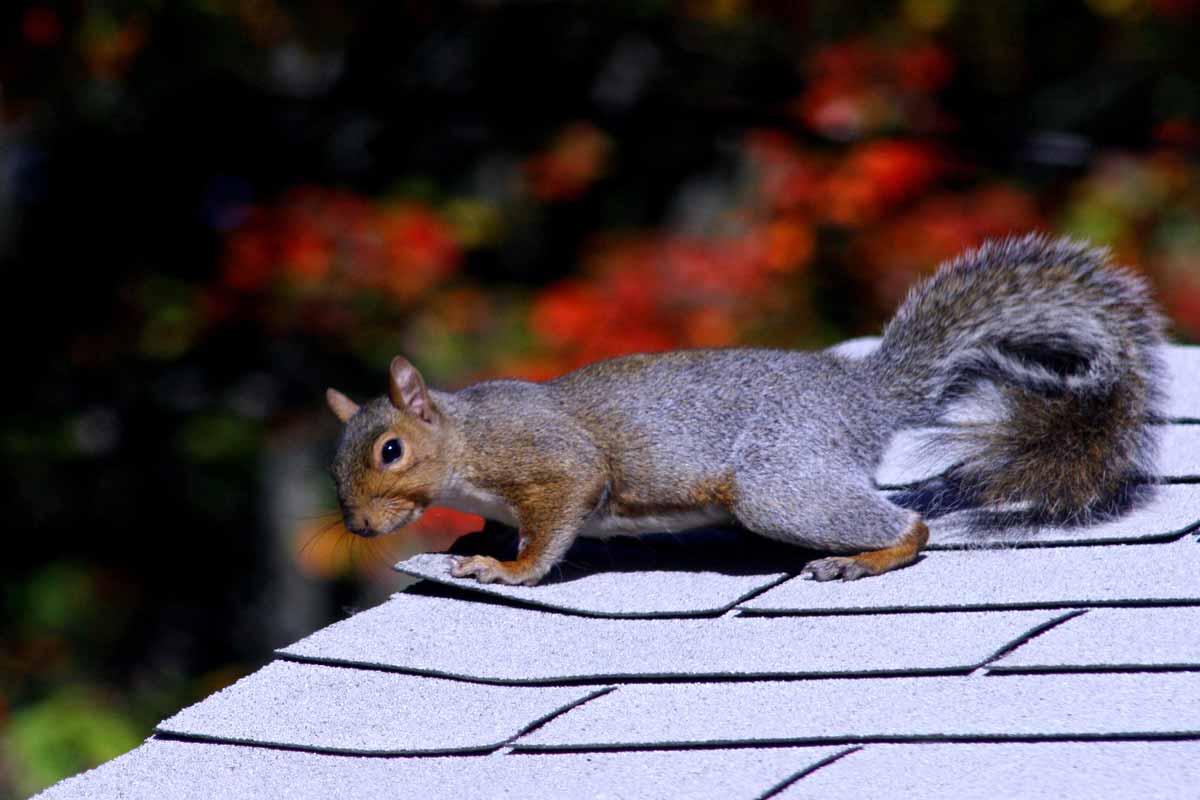
Gather The Tools You’ll Need
Gloves
to protect your hands from any mess left behind by a squirrel
Ladder
to reach areas you can’t see from the ground to determine access points for the animals
Flashlight
to see into dark or small places where squirrels might be causing damage
Squirrel Problem?
Squirrels don’t like chili pepper or cayenne pepper. If a squirrel is in your attic, chimney or outside your home, pour the pepper in the area to get them to leave.
How To Steps For DIY Removal
Squirrels can be some of the most destructive animals around if they find their way into your attic space or some other part of your home. They’re noisy, and they will gnaw and chew their way through just about anything in their path. If you think you have a squirrel problem, there are a few things you can do to try and get rid of them before you call in a professional.
Rake up the food source
If you have trees in your yard that produce nuts, berries or acorns, be sure to keep the fallen ones raked up. These are types of main food source for squirrels, and if a seemingly buffet is laying all over the ground, squirrels can easily access the food supply.
Move or get rid of the bird feeder
Squirrels will feed on the seed from your bird feeder. Because the feeder will provide a continuous food source, squirrels will often look to your home or attic to nest. You should move the feeder a good distance away from your home or remove it altogether.
Hit the spice cabinet
Squirrels don’t like chili pepper or cayenne pepper. If a squirrel is in your attic, chimney or outside your home, pour the pepper in the area to get them to leave.
Turn on the radio
Get a portable radio, turn it to a talk station and put it near the den or nest. Squirrels don’t like all the noise and will often leave on their own.
Install a one-way door
If you find the entry point, you can buy a one-way door at a hardware store or co-op. The squirrel will be able to leave, but not come back in. Once the squirrel has vacated the den or nest, permanently block the entrance with construction materials or wire mesh.
Get a motion activated sprinkler
Put the sprinkler near the area where the squirrels are causing the most problem. When they get near it, the sprinkler will go off and soak them. Squirrels typically don’t like this and will often find another place to forage.
Set a live trap
You can buy live traps from any home or garden supply store. You can put the trap in your attic and catch the squirrel. Once you’ve trapped it, it is recommended to release it close by and then seal up the entry point, so it can’t return.
Flush them out
If the problem you have is ground squirrels burrowing through your backyard, then turn on your water hose and put in the burrow. The animals will scamper out of the tunnel and look for a safer place to den.
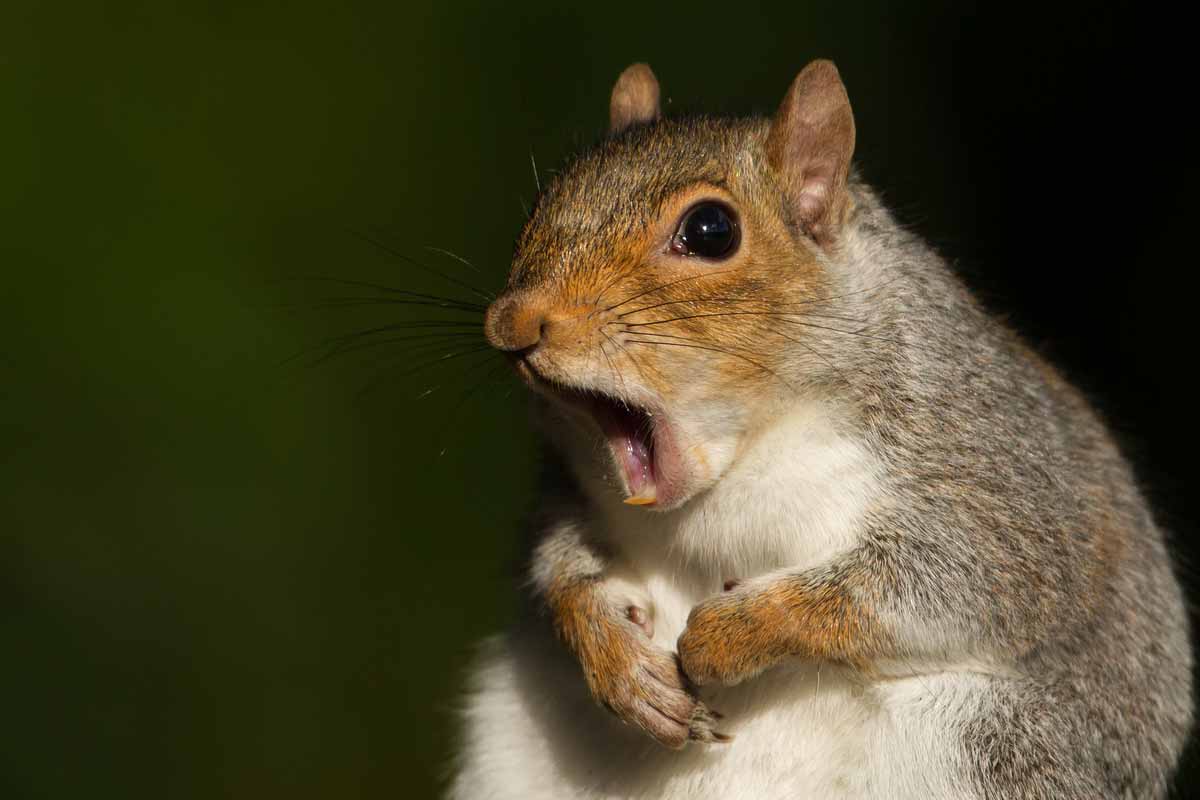
Squirrels can bite faster than snakes, and their strong jaws allow them to bite deeply.
Risks Of Disease
It can happen but catching a disease from a squirrel is rare. What humans should worry about more with squirrels is bite wounds. Squirrels can bite faster than snakes, and their strong jaws allow them to bite deeply. The deep wounds often happen on hands, and the bacteria from the bite can get into tissue around the bones or joints. If not treated quickly and effectively, the infection can set up in the bones or the joints.
If a squirrel bites you, clean the wound thoroughly and immediately and get to the doctor as quickly as possible to have it checked. Your doctor may recommend you receive a tetanus shot.
Tularemia can be contracted from handling the carcass of an infected squirrel. The infection causes flu-like symptoms with a fever that can run as high as 104. Most Tularemia infections can be treated successfully with antibiotics, but it’s difficult to diagnosis. Be sure and tell your doctor if you experience these symptoms and have touched a dead squirrel.
Squirrel Sounds
Squirrels are VERY vocal in communicating with one another, from chattering and chirping, to grunts and squeaks, to foot stomping and shrieking. Of course, non-verbal sounds—especially if they are in your attic and walls—include scratching, scraping, gnawing, and scurrying.
Squirrel Tracks
As a rodent, squirrels have five toes on both their front and hind paws with smaller front paws than hind. Their front paws are roughly half-inch by half-inch, the hind are longer—about an inch long and half-inch wide. In addition to the five clawed toes, they have several pads so some tracks may look like several little spots in addition to the toes. Tracks in mud or snow though, look more like handprints. Squirrels are also ‘bounders’ in their gait so tracks are often a foot or two apart.
Squirrel Poop
Squirrel droppings are usually small brown pellets about a half inch in length, with rounded ends, a little larger than rat droppings. Depending on species, they’ll be close in size to a jellybean, raisin, or pill. You’ll also find their poop in close proximity to the entrance they use to get into your home.
Prevent
Prevention Methods
Cover vents and the chimney
Buy professional vent covers and cover all the outside vents in your house. If you have a chimney, you should also purchase a chimney cap to secure it. Chimney caps should be made of steel mesh, so you don’t have to take it off when you get ready to use the fireplace.
Prune the trees
Keeping your tree limbs cut back is an excellent way to keep squirrels away. If you keep the tree branches several away from your roofline, they won’t be able to access your roof or your attic.
Maintain your property
Do regular checks in and around your property. Look for any kind of damage or holes caused by general wear and tear or storm damage. Properly seal and repair them to keep squirrels from nesting in your house.
Fence it in
Place wire fencing around any plants or crops you want to keep squirrels away from. It will protect your plants, especially in the early stages of growth.
Get a dog
Dogs that spend a lot of time outside are good deterrents for squirrels since squirrels perceive the animal as a threat.
Don’t feed the squirrels
Feeding squirrels in your yard will only cause them to come back continually. They will lose their fear of humans and can become aggressive if you don’t have food for them.
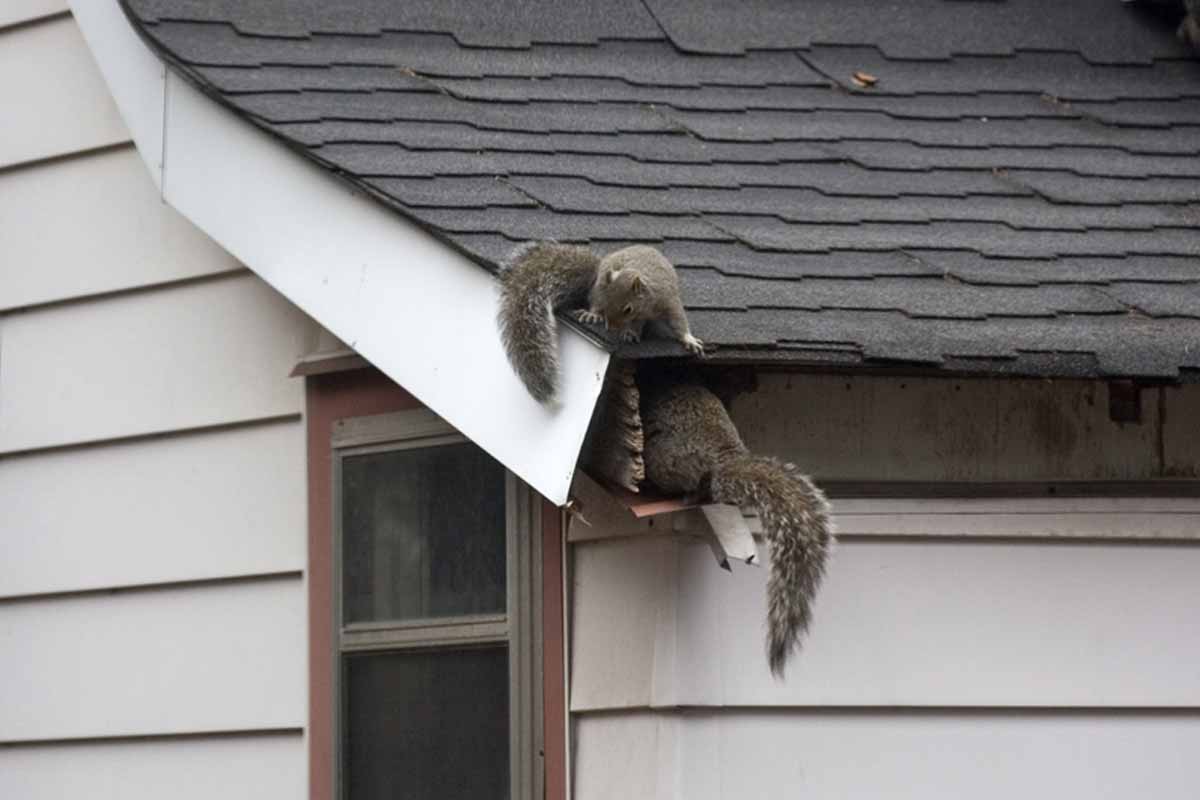
Squirrel Problem?
Squirrel Sounds
Squirrels are VERY vocal in communicating with one another, from chattering and chirping, to grunts and squeaks, to foot stomping and shrieking. Of course, non-verbal sounds—especially if they are in your attic and walls—include scratching, scraping, gnawing, and scurrying.
Squirrel Tracks
As a rodent, squirrels have five toes on both their front and hind paws with smaller front paws than hind. Their front paws are roughly half-inch by half-inch, the hind are longer—about an inch long and half-inch wide. In addition to the five clawed toes, they have several pads so some tracks may look like several little spots in addition to the toes. Tracks in mud or snow though, look more like handprints. Squirrels are also ‘bounders’ in their gait so tracks are often a foot or two apart.
Squirrel Poop
Squirrel droppings are usually small brown pellets about a half inch in length, with rounded ends, a little larger than rat droppings. Depending on species, they’ll be close in size to a jellybean, raisin, or pill. You’ll also find their poop in close proximity to the entrance they use to get into your home.
Squirrel Problem?
Squirrel Sounds
Squirrels are VERY vocal in communicating with one another, from chattering and chirping, to grunts and squeaks, to foot stomping and shrieking. Of course, non-verbal sounds—especially if they are in your attic and walls—include scratching, scraping, gnawing, and scurrying.
Squirrel Tracks
As a rodent, squirrels have five toes on both their front and hind paws with smaller front paws than hind. Their front paws are roughly half-inch by half-inch, the hind are longer—about an inch long and half-inch wide. In addition to the five clawed toes, they have several pads so some tracks may look like several little spots in addition to the toes. Tracks in mud or snow though, look more like handprints. Squirrels are also ‘bounders’ in their gait so tracks are often a foot or two apart.
Squirrel Poop
Squirrel droppings are usually small brown pellets about a half inch in length, with rounded ends, a little larger than rat droppings. Depending on species, they’ll be close in size to a jellybean, raisin, or pill. You’ll also find their poop in close proximity to the entrance they use to get into your home.
When to Call a Professional
Sometimes squirrels will enter your house through the pet door. If a squirrel does get in your home, that’s probably a good time to call a wildlife removal company. If you can, close all the doors in your house to contain the squirrel to one area and then get out of the house while an expert removes the animal.
https://www.nwf.org/Educational-Resources/Wildlife-Guide/Mammals/Flying-Squirrels
http://www.nhptv.org/wild/southernflyingsquirrel.asp
https://www.cdc.gov/rodents/diseases/direct.html
http://www.biokids.umich.edu/critters/Sciurus_carolinensis/
https://wdfw.wa.gov/conservation/gray_squirrel/
https://squirrelrefuge.org/page52.html
http://www.nhptv.org/natureworks/redsquirrel.html
https://kids.nationalgeographic.com/animals/eastern-gray-squirrel/#eastern-gray-squirrel-tree.jpg
http://naturemappingfoundation.org/natmap/facts/western_gray_squirrel_k6.html
http://www.nhptv.org/natureworks/redsquirrel.html
http://naturemappingfoundation.org/natmap/facts/western_gray_squirrel_k6.html
http://www.nhptv.org/natureworks/northernflyingsquirrel.html
http://www.nhptv.org/natureworks/easternfoxsquirrel.html
https://www.nationalgeographic.com/animals/mammals/group/squirrels/
http://www.nhptv.org/natureworks/easternfoxsquirrel.html
http://ipm.ucanr.edu/PMG/PESTNOTES/pn7438.html
https://www.psu.edu/dept/nkbiology/naturetrail/speciespages/graysquirrel.html
https://www.ncwildlife.org/Portals/0/Learning/documents/Profiles/Mammals/Gray_Squirrel.pdf
https://www.psu.edu/dept/nkbiology/naturetrail/speciespages/graysquirrel.html
https://audubonportland.org/wcc/urban/squirrels
Squirrel Problem?
Sources
https://www.trutechinc.com/services/animal-sounds/squirrel/
https://animals.mom.me/squirrels-make-noise-10587.html
http://www.wildlife-removal.com/squirreltracks.html
http://www.animalatticpest.com/squirrelfeces.html
http://www.247wildlife.com/squirrelfeces.html
https://www.critterriddertx.com/identifying-animal-poop-in-your-home/
Squirrel Sounds
Squirrels are VERY vocal in communicating with one another, from chattering and chirping, to grunts and squeaks, to foot stomping and shrieking. Of course, non-verbal sounds—especially if they are in your attic and walls—include scratching, scraping, gnawing, and scurrying.
Squirrel Tracks
As a rodent, squirrels have five toes on both their front and hind paws with smaller front paws than hind. Their front paws are roughly half-inch by half-inch, the hind are longer—about an inch long and half-inch wide. In addition to the five clawed toes, they have several pads so some tracks may look like several little spots in addition to the toes. Tracks in mud or snow though, look more like handprints. Squirrels are also ‘bounders’ in their gait so tracks are often a foot or two apart.
Squirrel Poop
Squirrel droppings are usually small brown pellets about a half inch in length, with rounded ends, a little larger than rat droppings. Depending on species, they’ll be close in size to a jellybean, raisin, or pill. You’ll also find their poop in close proximity to the entrance they use to get into your home.


